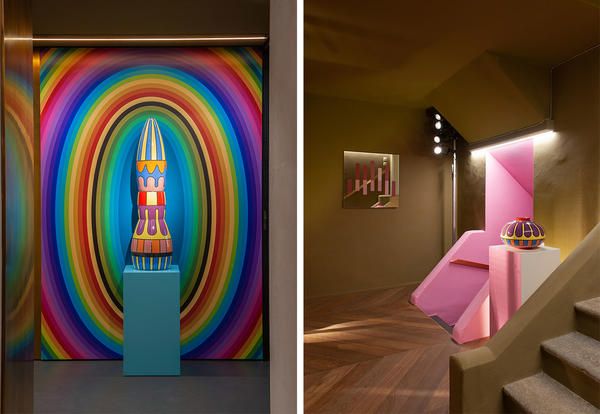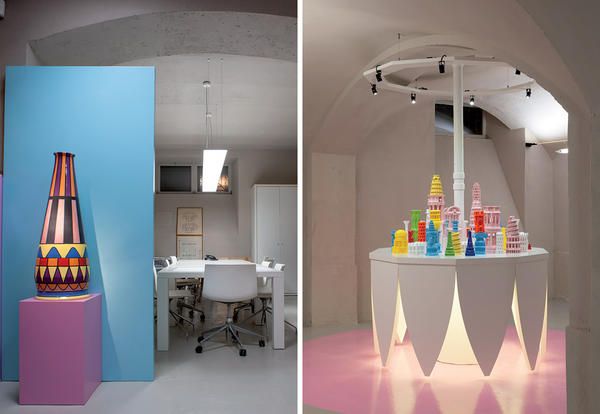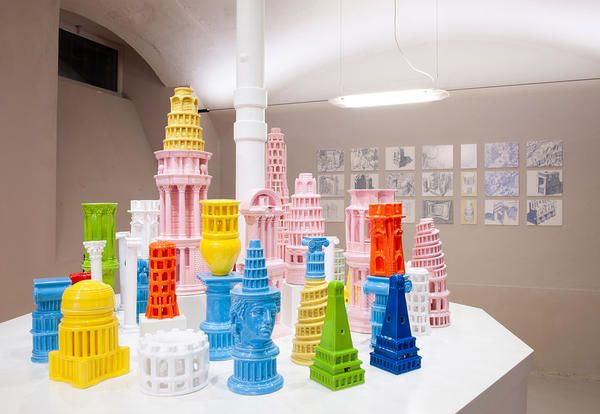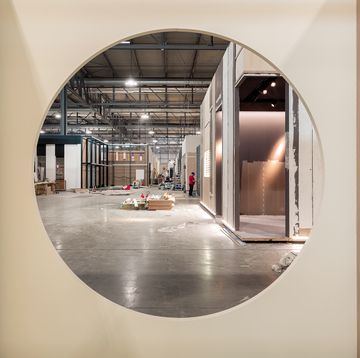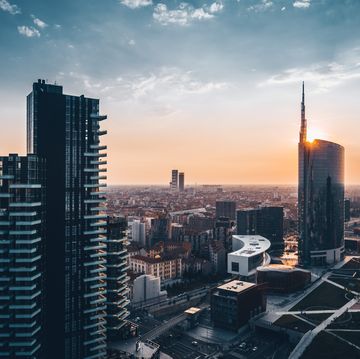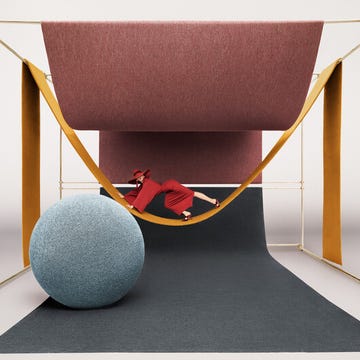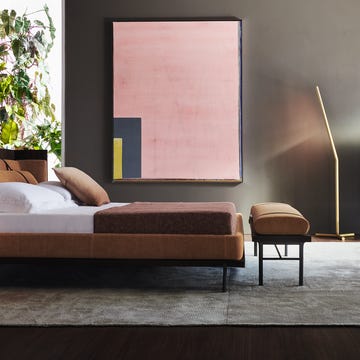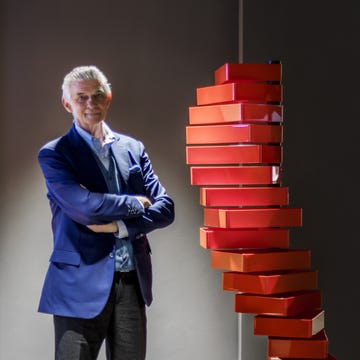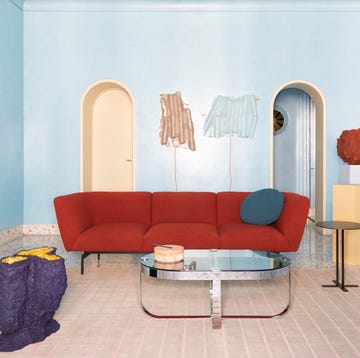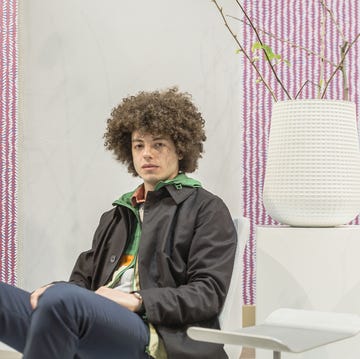Milan Design Week welcomes Historical Promiscuities, the title given to Adam Nathaniel Furman’s latest exhibit, curated by Luca Molinari in the studio of Vudafieri Saverino Partners. Filling the interiors of the architecture atelier within the Porta Venezia zone are two collections of ceramics in a constant dialog with the work spaces. Furman brings both a collection of micro-architecture previously showcased at Roman Singularity, for the reopening of the John Soane Museum of London, and an original project with Bitossi, the iconic Italian furniture brand known for giving life to numerous creations by Ettore Sottsass.
More than vases or accessories, the items on display represent symbolic objects, playing with recognizable forms covered in colored patterns to alter their identity. The entrance to the exhibit flaunts a colorful construction akin to a celebrated missile, while other ceramic pieces resemble the silhouette of an elongated tajine pan, or the perfect form to hug.
We sat down to speak with Adam Nathaniel Furman, one of the most enthusiastic and productive London designers, about Historical Promiscuities and much more.
How was the collaboration born with Vudafieri Saverino and with Bitossi? Was it a consequence of the exhibit at the Camp Design Gallery from last year?
It’s actually a funny anecdote. Luca Molinari began to follow me on Instagram and given that he was in London, he came to see Roman Singularity. After returning to Milan, he met with Claudio and Tiziano (Saverino and Vudafieri Ed.), telling them that we have to do something together. They were enthusiastic and so Luca wrote me in private, proposing a new collection. None of them knew about my former exhibit, Four characters in the first act, realized by Camp thanks to a collaboration with Abet Laminati, which like Bitossi, is a historic company. I’ve always wanted to work with this kind of Italian company, which has really supported a great generation of designers in this country. I’m a “Londoner”, but my father is Argentinian and my mother is half-Japanese, half-Israeli. My background allows me to jump from one culture to another very easily.
Does this cultural heritage influence your way of designing or does it bring you closer to design? I imagine then that your free use of colors comes from South America?
To be honest, it’s actually completely from Japan. Almost everyone has this kind of naive idea that the country is all zen and minimalistic, when it’s actually quite the opposite — there’s too much of everything! My grandma, for example, who is very Japanese, dresses very flashy. She looks like a living painting. When I was younger, I spent a lot of time in Buenos Aires, Tokyo, and Tel Aviv, creating an incredible melting pot of extreme culture. Jews from all over the world, Tunisia, Algeria, Yemen, Iran, India, Germany, USA, Russia, Poland, and Ethiopia protect distinctly different cultures, with different foods, ornamentation, decorations, architecture, songs, and languages. The fun part is that my father isn’t from Buenos Aires, but from the countryside, where the culture is very simple. His world is dominated by the color white, wood, and terracotta, with an emphasis on nature and simplicity. From him, I learned to appreciate craftsmanship, a skill that’s also widely found in Italian culture.
Do you believe that in a few decades, Europe will be a bit more like what you just described? Or cities like Tel Aviv, remaining as isolated experiences?
I’d consider myself very cosmopolitan. I’m very passionate about design and I have very strong political opinions. I’m a liberal, convinced that history pertains to us all — even the history of design isn’t divided by country, but rather, moves continuously through them. Today we have, on one hand, those who say “it’s cultural appropriation, you can’t use that”, and on the other, “it’s foreign, we only want things coming from there”. I’m in the middle somewhere, and I think we should should be mixing and sharing. I can get very passionate talking about these things, because there’s a political aspect in all of my projects.
I understood what you wanted to transmit in this sense, from the video accompanying Roman Singularity, with strong historic episodes featuring intervals of digital animations. It combines the bulk and monumentality of architecture with the power and negativity of social events.
I wanted to create a shocking contrast, even though I realized it’s not as clear for an Italian public. I believe, as a designer, in combatting through the practice of the creating, in order to make the world the way I want it: free, open, beautiful, loving, shared, sensual, intellectual, but also enjoyable.
Speaking of history, what are your thoughts on the revival of Post-Modernism?
I think this term, in reality, doesn’t exist. It’s just a name that has been assigned to a vast gamma of different things for over thirty years. The label doesn’t help. It just provides a pretext to reject something you don’t like. Radical architecture, radical design, queer design, historic revival, intuitive design in America, and the pop school of Santa Monica — there were many different movements happening in the same period that really weren’t connected. It was just that the public detested them and so decided to cluster it under “Post-Modernism”, in order to label and denigrate it. This happens in every generation and it also happened with Brutalism. It’s the name that’s problematic, because even within this current, you could identify different approaches, but when it obtained a name, it was categorized as something to refuse. With everything I do, I try to communicate that there a ton of beautiful things we need to do more research on, and protect, because otherwise they will probably be destroyed. Today, everyone thinks of Post-Modernism as garbage to throw aside, but we’ve just done the same thing with Brutalism. There are projects done well and projects done badly, but if we don’t discuss them, we’ll lose everything.
Because of this, my beliefs are continually attacked, with the arrogance to assume that I don’t understand Post-Modernism. The conclusion to my reasoning, is that there’s an entire period of prolific design and architecture history that has been completely forgotten. We need to force ourselves to remember and include these cases in retelling history. Obviously, I’ve now been labeled myself as the Post-Modernism revival designer.
You even wrote a book regarding this — Revisiting Postmodernism.
Those who read it, understand my point of view, while those who just read the title think I simply want to revisit Post-Modernism. “Revisiting” speaks to the way in which we can appreciate it, not how to bring it back to life. I wrote this book, but I also lead an association for the celebration of classical and modern architecture, so I’m very active in supporting those as well. Now, for example, I’m involved in a campaign to save several important modernist buildings in New York. I love architecture of all kinds — as long as it’s of good quality.
With an external outlook, do you get the feeling that this phenomenon occurs in Italy as well?
They’re different situations, but they still have a similar issue. Every generation and every country faces this kind of problem, but to tell the truth, this particular issue of Post-Modernism revival is hurting my career. My work method is similar to that of an artist: I write, I draw, I try patterns, and I love giving form to ideas. But I also like the intellectual component of the job, so I try to unite the two aspects. Those who see my work in England think it’s Post-Modern garbage — Millennial frivolity. Many young designers have to move abroad to work, given how aggressive the British are against new ideas.
In Italy we also have this feeling that the younger generation has to move abroad, but also because the institutions don’t help enough. What are your thoughts on this?
In England, it’s not so much the support that’s missing — I’ve personally been supported a lot by the London Design Museum, which has given me big opportunities. Same goes for the John Soane Museum and the British Academy. The institutions are mentally open, and while the curators working with them are fantastic, it’s the critics that are bi-dimensional and superficial.
I’m criticized for not being political enough, but the truth is that nobody asks me questions regarding politics. I’ve had great experiences with institutions, but I don’t want to do exclusively artistic productions, which I love; I’m a designer and I’d also like to do commercial projects, but the critical panorama makes it difficult.
What is your relationship with the curators?
The curators are a great help and they really appreciate the creative process. With Luca Molinari, we understood each other immediately. Even the curators I’ve worked with in London have developed positive experiences along my career, and working with Bitossi in this moment was also amazing.
Did you work directly with the company for the production phase?
I spent a few weeks to create an entire series of posters and I went to Bitossi in Montelupo with those. There I spent three really great days — big pages, my printed patterns, running all over to get the sample books. The second day, we tested the ceramics, which allowed me to change the form before the final product was decided. Then I returned to the computer and created new drawings, printing them and sharing them with the other members who understood my ideas. In England, I made a few mugs for the John Soane Museum, which were a big commercial success and I also worked with Royal Stafford, a historic English company, but didn’t have the same connection.
So you don’t imagine your work as collectible design, which is obviously great, but you’d rather reach the homes of everyone?
Absolutely, yes!!
Opening image: A PORTRAIT OF ADAM NATHANIEL FURMAN SURROUNDED BY THE VIBRANT COLORS.

